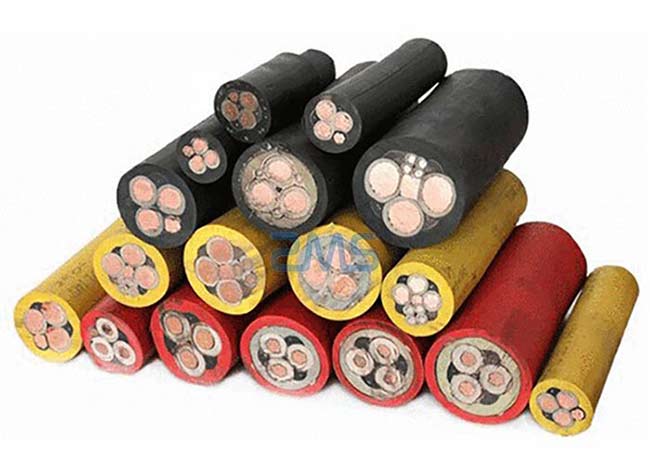The material of the cable also plays a decisive role in the quality of the cable. In the past, plastic cables were used more often, but gradually rubber cables began to replace plastic cables. So is it because rubber cable must be the best. Here let ZMS cable company’s editor explain the difference between rubber and plastic.

Broadly speaking, Rubber Is a Kind Of Plastic And Plastic Includes Rubber.
The most essential difference between plastic and rubber is that plastically deforms when plastic undergoes deformation, while rubber is elastic deformation. In other words, it is not easy to restore the original state of plastic after deformation, while rubber is relatively much easier.
The elasticity of plastic is very small, usually less than 100%, while rubber can reach 1000% or more. Most of the molding process of plastics is completed as the molding process of the product is also completed. While the rubber molding process is completed after the need for the vulcanization process.
Plastics and rubber belong to the same polymer materials, mainly composed of two atoms of carbon and hydrogen, and some contain a small amount of oxygen, nitrogen, chlorine, silicon, fluorine, sulfur, and other atoms.
Its properties are special and its uses are special. At room temperature, plastic is solid, hard, and cannot be stretched and deformed. While rubber is not hard, or elastic, can be stretched to become longer, stop stretching, and can return to its original state. This is due to the difference in their molecular structure.
Another difference is that plastic can be recycled and reused many times, while rubber can not be recycled directly, but only after processing into recycled rubber, and then available. The form of plastic at over 100 na 200 degrees is similar to the form of rubber at 60 na 100 degrees. Plastics do not include rubber.
Introduction To Rubber Wire And Cable Chlorosulfonated Polyethylene Rubber Applications
Types
Chlorosulfonated polyethylene is a derivative of polyethylene. depending on chlorine content and polyethylene molecular weight, chlorosulfonated polyethylene rubber has chlorosulfonated polyethylene 20, chlorosulfonated polyethylene 30, chlorosulfonated polyethylene 40, chlorosulfonated polyethylene 45. the wire and cable industry generally uses chlorosulfonated polyethylene 20, and chlorosulfonated polyethylene 40.
Characteristics
1. Have good physical and mechanical properties.
2. Has a good heat resistance and can be used continuously at a temperature of 120 ℃.
3. Excellent ozone resistance, sunlight resistance, and atmospheric aging resistance, outdoor exposure for six years without cracking.
4. Good flame resistance, second only to fluorine rubber and neoprene.
5. Excellent chemical resistance.
6. Good oil resistance.
7. Good resistance to corona and radiation.
8. It has good process performance and can be used with other rubbers.
The disadvantages of chlorosulfonated polyethylene rubber are slightly larger compression deformation and poor low-temperature performance. But because of its advantages, it is a very promising rubber in synthetic rubber.
Chlorosulfonated polyethylene 40 is often used for insulation and sheathing, and chlorosulfonated polyethylene 20 can be used for low-voltage wire insulation.
Rubber Wire And Cable With Silicone Rubber
First of all, silicone rubber is a special rubber, special in its heat resistance is very good.
The heat resistance is because its molecular chain consists of (-Si-O-) bonds, silicon-oxygen bonding energy than carbon bonding much larger 456>348kJ/mol, and Si is a non-combustible element, with the characteristics of inorganic materials, so the heat resistance is high. Silicone rubber has softness, can resist ozone, corona, and flame, has good insulation performance, high and low-temperature resistance (-60-200 ℃), and corona resistance and arc resistance is very good, is the production of wire and cable safe and reliable materials.
Secondly, cold resistance, coupled with heat resistance is to say that silicone rubber working temperature range is very wide, the same as above is also the reason is that the bond energy is large.
There are also good oil resistance, solvent resistance, radiation resistance and flame resistance, and good mold resistance; in addition, tasteless and non-toxic, no adverse effects on human health when used.
But he also has disadvantages: tensile strength, tear strength, and abrasion resistance at room temperature is much lower than natural rubber and other synthetic rubber, poor acid and alkali resistance, and expensive, poor processing performance.
Vinyl silicone rubber regardless of processability, physical and mechanical properties, high-temperature resistance, and compression permanent deformation in silicone rubber is relatively good and has more applications in the cable industry.
These are the differences and advantages and disadvantages of rubber cables and plastic cables in various aspects. No matter which cable is used, as long as it is suitable, it must be good to use. ZMS cable has been in the business for more than ten years, bringing better and more professional cables to our customers, with strict manual qualification audit, trustworthy.


